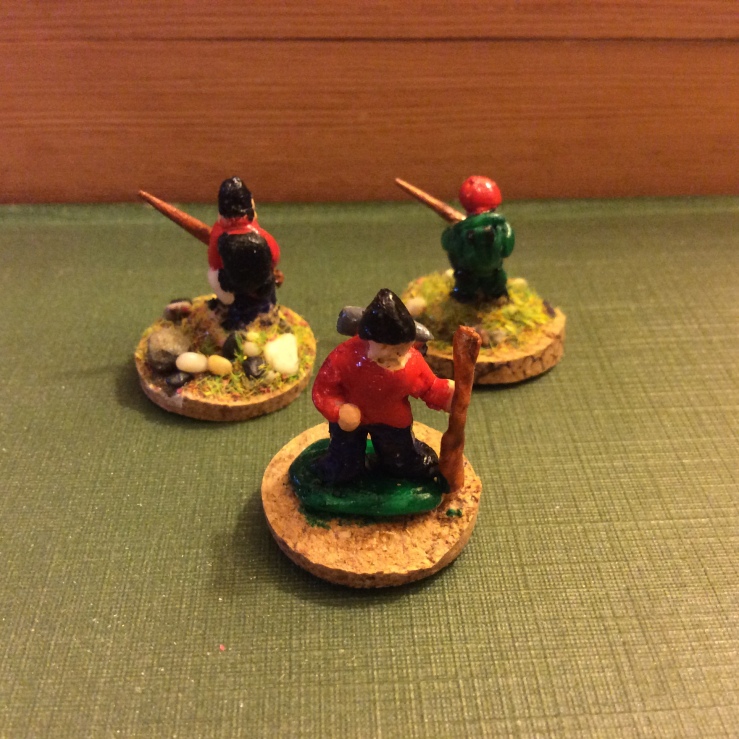
As well as metal mould figures, there are other materials to use in making your own figures for use in board games, wargaming and role playing games.
Polymer clay (Fimo in the UK and Europe, Sculpey in the USA) is oven baked, coloured or paintable, mouldable and easy to carve.
Part 1: Playing with Cake Mould soldiers
I have been experimenting with making different figures, firstly using silicon moulds and secondly freestyle Fimo or freehand.

One silicon cake mould obtained through Ebay and Etsy yielded a flat generic sort of “toy soldier guardsman“. This can be converted into many other figures with a little sculpting, cutting, painting and extra Fimo pieces or accessories.

I’m new to polymer clay and found it gets a bit clumsy with warmth from fingers (so pop in in the fridge for a minute or two sometimes). I also found it pays to bake them flat, as adding back packs too early can lead to cracking or bending if they don’t lay flat on a baking tray / baking paper.

Carving hats or changes of headgear allows figures to be converted from the standard guardsman to represent different periods such these American Civil War type figure or Russian looking figure.

Back views show additional backpacks, water bottles etc to give a rounded feel to what are otherwise flat backed figures.

I’m also quite new to acrylic paints, having grown up with enamel model paints. Enamel paints proved far too stinky for use in a shared household / kitchen table crafting space (without a crafting room), so low odour Revell Gloss Acrylics from my local hobby store have proved a good alternative and far more family friendly.
I do find these acrylics dry quickly but remain ever so slightly tacky for a while especially on Fimo / Polymer clay, so attracting dust!
Not yet decided on whether to varnish or not and if so, how.
Part 2: Freestyle or Freesculpted Fimo – Frustrating First Attempts
The first family gift of Fimo this year was off white or flesh coloured. Playing with this trial pack to make figures led to some frustrating disasters and other figures that are more promising.
Experiment and practice will no doubt help my next attempts at free sculpting.

Polymer clay gets a little droopy or saggy with warmth, so my first attempt to free sculpt this flag bearer figure is far clumsier and more cracked than I wished.
I reinforced the figure around a cocktail stick skewer or internal splint before baking upright but this probably led to more cracking!
Smaller Freesculpt Polymer Clay figures
First attempts with smaller free sculpt figures suffered more similar stockiness of figure than desired, again from finger warmth and sagginess. However with paint, some interesting figures developed.
No particular period figures were in mind when playing around with these first attempts.

Mounted or based on scalpel cut sliver circles of wine bottle cork to be painted or flocked.
Pin or shaved matchstick / cocktail stick weapons to be added.

Other slightly smaller figures sometimes suggest sometimes redcoats, sometimes more modern soldiers, maybe a red beret paratrooper or airborne brigade; this is what emerges whilst free sculpting.


Not always sure what these figures are or will turn out to be. A bit of fun and a learning process.
On the plus side, polymer clay (Fimo) figures are amazingly light and very versatile. They are also pleasing to create and pretty cheap, although not as cheap as pound store figure conversions.
Too late for my first attempts, I rediscovered on the Vintage Wargaming blog a version of the long remembered article about Fimo figures with some helpful hints like building and baking sections (legs etc) as you go to prevent stocky figure / sagging problems.
http://vintagewargaming.blogspot.co.uk/2009/11/creative-clay-modelling-from-practical.html
The silicon cake mould figures I featured on my blog sometimes seem so much easier than these free sculpts for slightly larger quantities.
Buying plastic or metal figures sometimes seems easier. However Donald Featherstone in his 1962 book War Games, before many figures were easily available, celebrated the mancraft and boycraft of DIY making your own figures, terrain and rules (page 21):
“There is a great deal of satisfaction in making one’s own armies, either in their entirety or by conversions.” (Page 21)
“Part of the fun of being a war gamer lies in the making of one’s own soldiers as distinct from purchasing figures of different sizes obtainable from makers in various parts of the world.” (Page 18, War Games)

I will post more pictures as I experiment with other variations on these basic mould figures and other materials.
Happy gaming!
Posted by Mr MIN, Man of TIN, May 2016.
